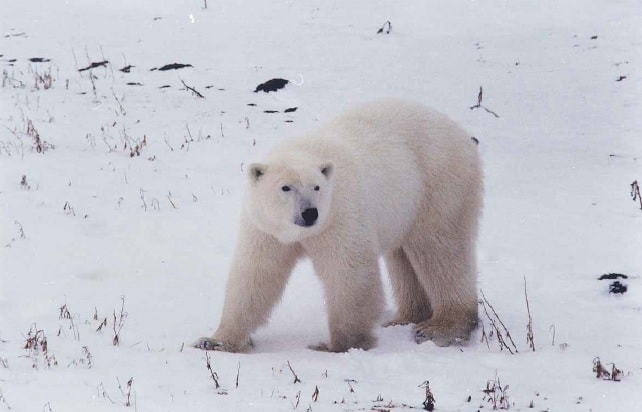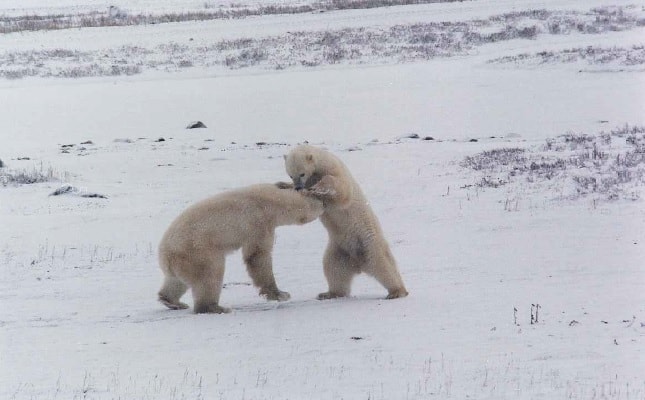Churchill Tours
Churchill Tour via Hudson Bay
Spend a relaxing holiday with beautiful, natural scenery in Northern Manitoba and tour our nearest Sea Port!
- Free Parking in Hudson Bay, Saskatchewan
- Motels available for your travel convenience at Hudson Bay and Churchill
Trains leave Hudson Bay every Sunday and Tuesday; returning to Hudson Bay on Thursday and Saturday. Current round trip fares and a brochure are available at the Town Office.
Via rail from Hudson Bay:
For more information on travel
Phone VIA Rail: 1-888-842-7245
Website: www.viarail.ca
Bird Watching: June
Whale Season & Wild Flowers: July & August
Polar Bears & Seals Season: Oct. & Nov.
Churchill is one of the easily accessible human habitats to view the Northern Lights, Beluga Whales, Arctic and Sub arctic Bird Species and Polar Bears in the wild.
In the spring and fall, the vast tundra\’s thin covering of moss, lichens and miniature shrubs and flowers burst into a dazzling array of reds, violets and yellows. More than 400 native plant species can be seen. Come fall, the ground is a scarlet carpet of bearberries and yellow willows interspersed with the downy white tufts of arctic avens.

At spring breakup, low tides deposit icebergs shaped into fantastic sculptures by the erosion of river currents and tides.
Churchill\’s five million bushel Grain Complex looms up over the harbor. It can load grain at the rate of 60,000 bushels per hour. Ocean going vessels arrive in July and depart by the end of October.
There is also Cape Merry, Sloop Cove, Wapusk National Park, Eskimo Museum and the Boreal Gardens as well as the many local shops where crafts, beaded mitts, moccasins, parkas, stone cut prints and stone sculptures are available in abundance.
The Churchill Northern Studies Centre is one of the few places in the world where the public can enroll in arctic studies such as arctic ecology, photography and ornithology under the tutelage of visiting professors, guest speakers and specialists.
Phone: (204) 675-2307
E-mail: [email protected]
Prince of Wales Fort
A massive stone fortress at the mouth of the Churchill River was built on permafrost; with construction beginning in 1731 and ending 40 years later. A dark silhouette on the treeless tundra, the Fort is an imposing structure, with 40 cannons mounted on walls 40 feet (12 metres) thick.
The company intended to be an impregnable English stronghold during the English-French struggle for North America; ironically however, the only attack, in 1782, saw the great white explorer and fur trader Samuel Hearne, and his handful of men quickly surrender to the French.
Fort Prince of Wales is accessible by boat during the brief Arctic summer. The trip across the Churchill River is enhanced by the Beluga Whales that often follow the boats and can be viewed at close range. The unique coastal sub-arctic wilderness is a haven for naturalists and is home to the world\’s largest concentration of polar bears, as well as to seals, caribou, wolves and many nesting and migratory birds. The rich resources of the area have attracted attention since the 18th century, when Canada\’s pioneer naturalists recorded observations of birds, plants and animals.
Aurora Borealis
The intensity of the auroral activity is at its highest in this region. August through to April are the best times to see this spectacular phenomenon. Local legend is if you whistle at the aurora it makes them dance and come down to the ground. For a clear and comfortable viewing go to the indoor facility Tundra Domes.
Birding
Close to 200 species of birds congregate in Churchill during the summer and fall. A native of Siberia the rare and beautiful Ross\’ Gull is perhaps dearest to the birder\’s heart. The Arctic Tern is one of the most fascinating summer visitors. The Tern has an incredible migration pattern from pole to pole twice a year that gives them more hours of sunlight than any other creature on earth.
Beluga Whales
Each summer shortly after the ice breaks up some 3,000 Beluga Whales move into the Churchill River area. Most of July and August these highly intelligent mammals spend their time in warmer waters of the river mouths flowing into Hudson Bay. Their strange vocalizations have won them the nickname “sea-canaries. Tours operate special hydrophone-equipped boats offering unforgettable whale watching. The more adventurous can try snorkeling alongside the beluga whales.
Polar Bears
In the fall the biggest attraction is the Polar Bears. It is quite common for everything in town to be all booked up during this busy season. As the ice freezes first at points such as Cape Churchill, the bears congregate, waiting to move onto the ice for winter.
Called the “Lords of the Arctic” these magnificent animals weigh an average of 660 lbs for females and 1320 lbs for males. These skilled hunters can pick up a scent 20 miles away and detect the seals under their feet on the snow and ice. Special vehicles designed to travel on the tundra are the safest and warmest ways to watch the polar bears saunter, pigeon-toed, as they forage for a meal. In some instances the polar bears will come within a few yards of the tundra vehicles to investigate – standing on their hind legs looking into the window. It is essential to book these vehicles well in advance.

